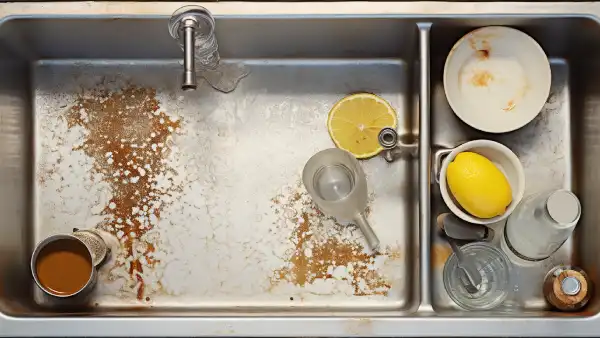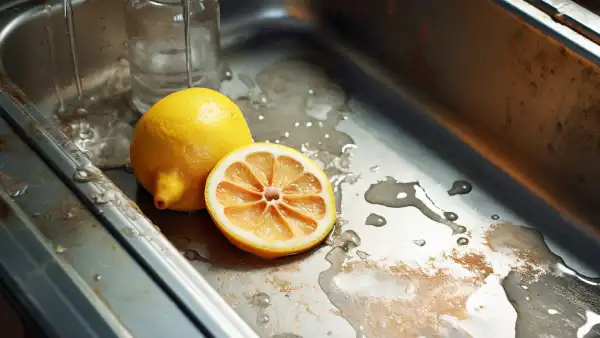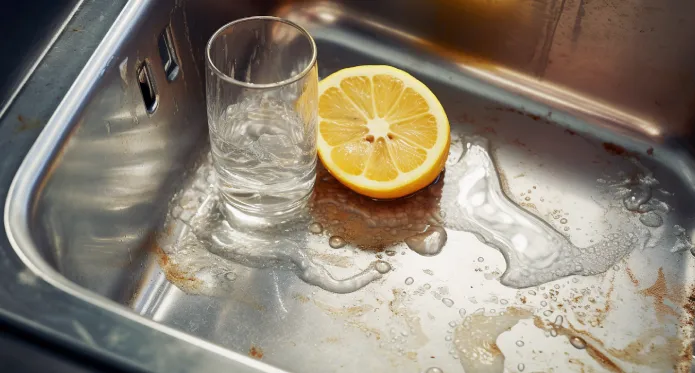Last Updated on November 14, 2023
A stainless steel kitchen is corrosion-resistant but can rust if not properly cared for and maintained. Rust stains and deposits detract from the sink’s aesthetic appeal and can compromise its longevity. That’s why you need to know how to remove rust from a stainless steel sink to restore its shiny clean look.
Create a paste using baking soda and water, then scrub the rusted areas with a sponge or cloth. Another option is using a cleaner that contains oxalic acid, which can help dissolve the rust stains.
You can also try a mixture of white vinegar and water to remove the rust or use a commercial rust remover specifically designed for stainless steel surfaces.
Here, we will discuss some practical cleaning methods with step-by-step guides to remove rust from your stainless steel kitchen sink. We will also explain the causes of rusting the sink and how to prevent it.
How Do You Remove Rust From Your Stainless Steel Kitchen Sink?

Your stainless steel sink may have light or heavy rust stains, and you can use different methods depending on the severity of the rust. Here are the methods for cleaning rust from your stainless steel kitchen sink and select which one you need:
- Method 1: Baking soda paste
- Method 2: Cleaner with oxalic acid
- Method 3: White vinegar and water mixture
- Method 4: Commercial rust remover
Method 1: Using Baking Soda Paste
You can effectively remove rust from your stainless steel kitchen sink by applying a thick baking soda paste and letting it sit for a few minutes.
To create the paste, mix baking soda with a small amount of water until you have a thick, spreadable consistency. Cover the rusted areas evenly with the paste, using your fingers or a soft cloth.
Gently rub the paste into the rusted spots in a circular motion, following the stainless steel grain to prevent scratching. Allow the paste to sit for 5 to 10 minutes, giving it time to react with and loosen the rust.
Afterward, rinse the sink thoroughly with warm water and wipe away any residue. Your sink will be rust-free and look as good as new.
Method 2: Using a Cleaner with Oxalic Acid
If the rust on your stainless steel kitchen sink is stubborn, try using a cleaner with oxalic acid, which can be highly effective in removing rust.
To begin, select a cleaner specifically containing oxalic acid and follow the instructions on the package for application and safety precautions.
Apply the cleaner to the rusted areas of the sink, wearing appropriate safety gear like gloves and eye protection. Gently rub the cleaner into the rusted spots using a soft, damp sponge, following the grain lines of the stainless steel to avoid scratching.
Once the cleaner has been rubbed in, thoroughly rinse the sink with warm water to remove any remaining traces.
Always exercise caution when working with chemicals, especially those containing oxalic acid, by following the safety guidelines.
Method 3: Using White Vinegar and Water Mixture
A mixture of white vinegar and water is an effective and natural way to remove rust from a stainless steel kitchen sink.
Start by preparing the solution with equal parts white vinegar and water. Apply the solution directly onto the rusted spots and thoroughly saturate the area. Let the vinegar solution sit for at least 15 to 20 minutes to allow it to break down and loosen the rust.
Then, using a non-abrasive sponge or a soft-bristle brush, gently scrub the rusted areas toward the stainless steel’s grain to prevent scratching. Ensure the sink is thoroughly rinsed with warm water to remove the vinegar solution and any loosened rust particles.
Method 4: Using Commercial Rust Remover
If you want to effectively remove thick rust from your stainless steel sink, make sure that you use a commercial rust remover that is specifically designed for stainless steel sinks. These products are formulated to effectively dissolve and remove rust stains without causing any damage to your sink.
Apply the rust remover to the affected areas and let it sit for the recommended amount of time.
Then, gently scrub the rusted blemishes using a soft cloth or sponge, always keeping the stainless steel grain in mind. Ensure the sink is thoroughly rinsed with warm water to wash away any residue and dry it with a clean towel.
How to prevent rust from forming on a stainless steel kitchen sink?
You should regularly clean and dry your stainless steel kitchen sink to prevent rust from forming. Remove any rubber mats, dish rags, or cleaning utensils from the sink, as they can trap moisture and promote rust.
Avoid using abrasive pads, steel wool, or harsh cleaning chemicals that can damage the stainless steel surface. Instead, clean and rinse the sink thoroughly after each use to remove any corrosive residues.
Using a sink grid can also help protect the kitchen sink’s surface from direct contact with pots and pans. Also, avoid exposing the sink to aggressive chemicals and always dry dishes or cookware on top of a sink grid rather than directly on the sink.
What causes rust in the stainless steel kitchen sink?

If you notice rust in your stainless steel kitchen sink, it’s likely caused by factors such as high iron content in water or the use of steel soap pads or wire brushes.
When water with high iron content evaporates on the kitchen sink’s surface, it can leave behind a rusty residue. Also, using steel soap pads, steel wool, or wire brushes can scratch the stainless steel sink’s surface, making it more susceptible to rust formation.
Chlorides from detergents can also lead to rust build-up and pitting if not properly rinsed off. Furthermore, leaving metal cookware, baking sheets, or flatware in the sink can cause rust-like stains when the rust mixes with water and dries.
Is it normal for stainless steel sinks to rust?
If you have a good-quality stainless steel sink, it’s quite rare for it to rust. Still, it isn’t uncommon to see rust stains on the sink. The easiest way to prevent rust from forming is to regularly clean the sink with warm, soapy water and a soft cloth.
Get Rid of Rust Stains in Your Stainless Steel Sink
Now, you know a simple yet effective way to remove rust from your stainless steel kitchen sink. Keep your sink regularly clean and dry your sink to stop rust from forming in the first place.
Whether you opt for natural remedies like baking soda and vinegar or specialized rust removers, these methods can help you eliminate unsightly rust stains.
It is wise to understand the causes of rust and taking the proactive measures we discussed above will keep your stainless steel sink looking brand new.

